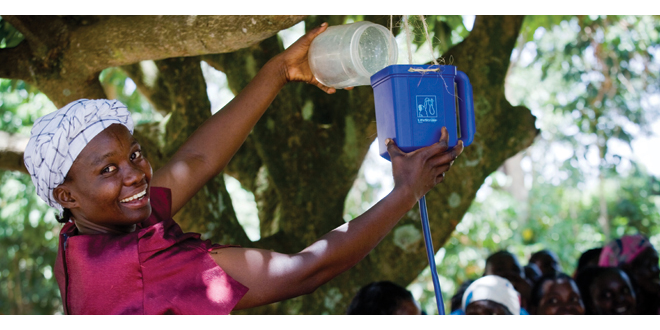
Date: 2024-05-15 Page is: DBtxt003.php txt00009219
Initiative
Forum for the Future
ClimateCare ... What health funding can learn from carbon
Burgess COMMENTARY
Peter Burgess
What health funding can learn from carbon

Outcome-based investment models, already pioneered in carbon finance, could bring private funding to ‘development’ projects.
In Kenya, health workers with smart phones and questionnaires will call on every family that received a LifeStraw water filter (pictured) in a recent project developed by health experts Vestergaard Frandsen in collaboration with ClimateCare. That’s nearly 900,000 families in total. Each one will be asked questions about the incidence of water-borne disease. This data, combined with reports from regional health centres, will be checked against a pre-project baseline. The same families will receive another visit six months later, and six months after that…
This sort of rigorous impact measurement is opening up the possibility of new project funding streams that are health related and paid by result. Investors seeking specific health impacts can provide pre-agreed payments for health outcomes. For example, in the case of the water filters, payments could be made if the project achieves a 25% reduction in the odds of diarrhoea within one year.
This is the vision of Edward Hanrahan, Director of ClimateCare, who believes such a model could unleash funding for development projects on a scale never seen before.
As calls for the private sector to contribute to the hundreds of billions of dollars needed to tackle climate and development challenges become louder, the results-based approach pioneered in the carbon market over the last decade could offer a way forward.
Donors are increasingly looking to fund organisations and specific projects based upon the results they achieve, rather than the proposals they submit. Such ‘results-based payments’ are hailed as a way to unlock private sector finance, but are often considered a concept rather than accepted practice. However, carbon finance, where payments are only made once a project has delivered quantified CO2 reductions, is an example of such a model in action.
The Carbon for Water project is one of the first schemes in the world to attempt to monitor and verify health outcomes with the same rigour as for carbon reductions, although, for the moment, the financial structure remains a carbon-based one. Vestergaard Frandsen put forward $25 million to deliver the LifeStraw water filters, on the basis that there would be a return from selling the emissions reductions generated over a 10-year period.
However, it represents a crucial step towards Hanrahan’s vision of large-scale private investment based on health and other development outcomes. While it’s by no means a simple task, Hanrahan believes that developing an internationally accepted mechanism to measure and value such outcomes could be the quickest way to unlock the private sector finance required to meet development and climate change targets.
The risks for investors could be reduced through ‘blended finance’ models, bringing together traditional funders like development finance institutions and governments with private sector investors. For instance, the model mentioned earlier – in which traditional funders commit to pay for pre-agreed development outcomes – provides assurance to private sector investors that the project has a long-term revenue stream, reducing risk and encouraging initial investment.
ClimateCare is working with corporate, government and NGO partners to develop projects that reduce carbon, tackle poverty and improve health.
As large corporations start to recognise their roles and responsibilities with regards to international development, it is no longer a question of dragging finance from a reluctant private sector. Strategic, innovative businesses are looking for the kinds of funding mechanisms and partnerships that ClimateCare cultivates. With the right models in place, they could change the scale of development, for good.
ClimateCare is a Forum for the Future partner.
Photo: Kate Holt